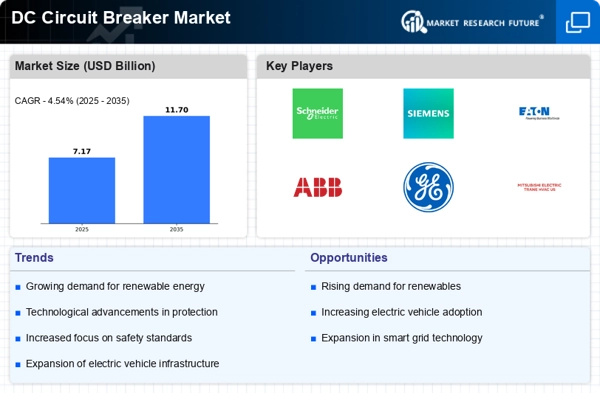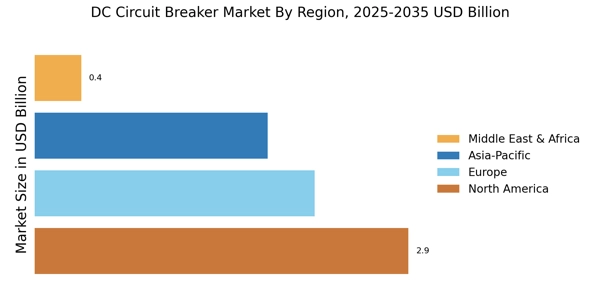Rise in Electric Vehicle Adoption
The DC Circuit Breaker Market is poised for growth due to the rising adoption of electric vehicles (EVs). As the automotive industry shifts towards electrification, the demand for efficient charging infrastructure is escalating. DC circuit breakers are essential components in EV charging stations, providing protection against overcurrents and ensuring safe operation. Recent statistics indicate that the number of electric vehicles on the road is expected to surpass 300 million by 2030, which will significantly increase the need for reliable circuit protection solutions. This trend not only enhances the safety of EV charging systems but also drives innovation within the DC circuit breaker market, as manufacturers develop products tailored to the specific requirements of electric vehicle applications.
Expansion of Renewable Energy Sources
The DC Circuit Breaker Market is significantly influenced by the expansion of renewable energy sources. As countries strive to meet their renewable energy targets, the integration of solar and wind power into the energy grid is becoming more prevalent. DC circuit breakers play a crucial role in managing the unique challenges posed by these energy sources, such as variable output and the need for rapid disconnection during faults. The International Energy Agency reports that renewable energy capacity is expected to increase by 50% by 2025, necessitating advanced protection solutions like DC circuit breakers. This growth not only supports the transition to cleaner energy but also creates a robust market for innovative circuit protection technologies.
Increasing Demand for Energy Efficiency
The DC Circuit Breaker Market is experiencing a notable surge in demand for energy-efficient solutions. As energy costs continue to rise, consumers and businesses alike are seeking ways to reduce their energy consumption. This trend is particularly evident in sectors such as manufacturing and commercial buildings, where energy efficiency can lead to substantial cost savings. The implementation of DC circuit breakers, which offer superior performance in energy management, is becoming increasingly attractive. According to recent data, the energy efficiency market is projected to grow at a compound annual growth rate of over 8% in the coming years, further driving the adoption of DC circuit breakers. This shift towards energy efficiency not only aligns with regulatory requirements but also enhances the overall sustainability of energy systems.
Regulatory Support for Safety Standards
The DC Circuit Breaker Market is also driven by regulatory support for enhanced safety standards in electrical systems. Governments and regulatory bodies are increasingly implementing stringent safety regulations to protect consumers and infrastructure. These regulations often mandate the use of advanced circuit protection devices, including DC circuit breakers, to mitigate risks associated with electrical faults. As a result, manufacturers are compelled to innovate and comply with these standards, leading to a more competitive market landscape. The emphasis on safety not only fosters consumer confidence but also encourages investment in advanced circuit protection technologies, thereby stimulating growth within the DC circuit breaker market.
Technological Advancements in Circuit Protection
The DC Circuit Breaker Market is benefiting from rapid technological advancements in circuit protection solutions. Innovations such as digital monitoring and smart circuit breakers are enhancing the functionality and reliability of DC circuit breakers. These advancements allow for real-time monitoring of electrical systems, enabling proactive maintenance and reducing downtime. The market for smart circuit breakers is projected to grow significantly, with estimates suggesting a CAGR of over 10% in the next five years. This technological evolution not only improves safety and efficiency but also aligns with the increasing demand for smart grid solutions, further propelling the growth of the DC circuit breaker market.


















Leave a Comment